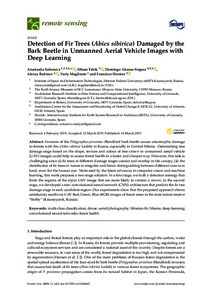Detection of Fir Trees (Abies sibirica) Damaged by the Bark Beetle in Unmanned Aerial Vehicle Images with Deep Learning
Скачать файл:
DOI:
10.3390/rs11060643URI (для ссылок/цитирований):
https://www.mdpi.com/2072-4292/11/6/643https://elib.sfu-kras.ru/handle/2311/128709
Автор:
Safonova, A.
Tabik, S.
Alcaraz-Segura, D.
Rubtsov, A.
Maglinets, Y.
Herrera, F.
Коллективный автор:
Институт космических и информационных технологий
Кафедра систем искусственного интеллекта
Дата:
2019-03Журнал:
Remote SensingКвартиль журнала в Scopus:
Q1Квартиль журнала в Web of Science:
Q1Библиографическое описание:
Safonova, A. Detection of Fir Trees (Abies sibirica) Damaged by the Bark Beetle in Unmanned Aerial Vehicle Images with Deep Learning [Текст] / A. Safonova, S. Tabik, D. Alcaraz-Segura, A. Rubtsov, Y. Maglinets, F. Herrera // Remote Sensing. — 2019. — Т. 11 (№ 6). — С. 643Аннотация:
Invasion of the Polygraphus proximus Blandford bark beetle causes catastrophic damage to forests with firs (Abies sibirica Ledeb) in Russia, especially in Central Siberia. Determining tree damage stage based on the shape, texture and colour of tree crown in unmanned aerial vehicle (UAV) images could help to assess forest health in a faster and cheaper way. However, this task is challenging since (i) fir trees at different damage stages coexist and overlap in the canopy, (ii) the distribution of fir trees in nature is irregular and hence distinguishing between different crowns is hard, even for the human eye. Motivated by the latest advances in computer vision and machine learning, this work proposes a two-stage solution: In a first stage, we built a detection strategy that finds the regions of the input UAV image that are more likely to contain a crown, in the second stage, we developed a new convolutional neural network (CNN) architecture that predicts the fir tree damage stage in each candidate region. Our experiments show that the proposed approach shows satisfactory results on UAV Red, Green, Blue (RGB) images of forest areas in the state nature reserve “Stolby” (Krasnoyarsk, Russia).

